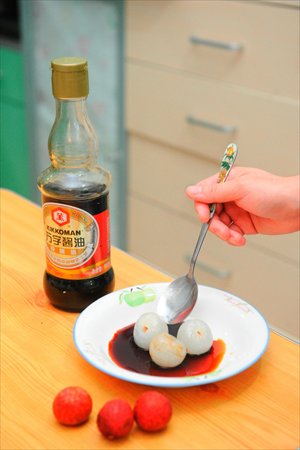HOME >> METRO BEIJING
Twisted Cookery
By Yin Lu Source:Global Times Published: 2013-7-18 18:23:01

How does the delicate sweetness of lychee fare when dipped in the earthy saltiness of soy sauce? Photo: Li Hao/GT
Foodies, if you haven't heard about Dark Cooking, you are seriously behind the times!
Test your gag reflex with these new recipes (but tie your hair back in case you fail and find yourself retching): instant noodles soaked in an infusion of indigowoad root (a black TCM herb), lychee dipped in black soy sauce, bananas dipped in fermented bean curd, submarine sandwiches filled with instant noodles and topped with cream, stir-fried apple and watermelon, fried kiwi and eggs, etc.
These new dishes have triggered nausea and delight in many people - all at the same time. They have been forwarded tens of thousands of times online and commented on enthusiastically. Many netizens have even personally tested them out.
Jean Chang, in her forties, likes to try new things, so when she saw a recipe for "Oreo rice," she didn't hesitate. By adding milk and Oreo cookies to raw grains of rice before steaming, Chang ended up with a dark lump of mysterious black rice.
"Ewww!" Looking at the dish, Chang's husband and friends declared it an "appetite suppressant." But her 5-year-old daughter liked it, and Chang said the rice was surprisingly sweet and fragrant.
The term Dark Cooking originates from a popular Japanese manga from the 1990s called Chka Ichiban! ("China's Number One!"). In this fictional universe, the evil Dark Cooking Society's goal of controlling the country is foiled by a young boy with prodigious cooking talent.
What unites all the real-world Dark Cooking dishes is a freakish appearance, unusual taste, bizarre preparation, or incomprehensible combination of flavors (such as salty and sweet) or ingredients (Western and Asian).
Some dishes are considered "dark" because they contradict our conventional eating habits. But isn't "normal" is simply a set of ingrained cultural habits?
In terms of culinary shock value, the precursor to China's Dark Cooking was a food blog that went viral in China last year, named "The English Can Cook." The images of haggis, curried banana, noodle kugel cake, eggplants in chocolate and other outlandish-looking dishes seemed terribly exotic to Chinese people, whose confidence in their own cuisine led them to make fun of the English and their cooking techniques.One of the most remarked-upon dishes was "stargazy pie," in which whole fishes are baked in a pie with their head sticking up out of the crust, as if they had died with everlasting regret.
The Internet thrives on new and bizarre things that can be mocked. But not everybody likes the idea of Dark Cooking. Food blogger Olivia Wang calls it "a waste of food."
Nutritionist Yang Wenjiao told Metropolitan that the combination of black and yellow in the indigowoad instant ramen is naturally very repulsive. "People prefer food with a harmonious combination of colors, which whets the appetite," said Yang. She noted, however, that the ingredients of the aforementioned recipes are not nutritionally incompatible, as far as she knows.
In fact, in Guangdong Province and Guangxi Zhuang Autonomous Region, there is a long history of dipping not just lychees but also mangos and plums in soy sauce. "The saltiness can highlight the sweetness and fragrance of the fruits, making them less cloying," said Yang.
If you'd like to be part of the Dark Cooking Society, the latest trend is to shake a box of Lotte Koala cookies until they become one big moist cookie ball. An online contest encouraging the practice has attracted more than 2,200 participants.
But don't try it unless you're willing to fully commit to Dark Cooking. When Xiao Jing, 16, shook a box, instead of ending up with one big ball, she got several smaller balls. "They looked like goat shit, and tasted terrible!" she said.
Posted in: Metro Beijing